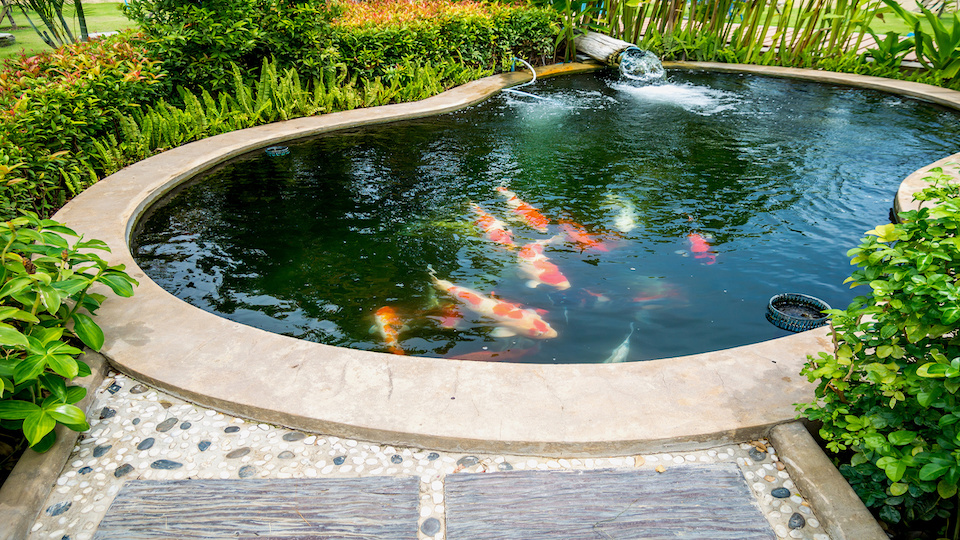A water feature provides a soothing, pretty element to your backyard. It may attract wildlife too. There are many reasons to have a backyard water garden, but it is not necessarily an easy undertaking. A big pond with a waterfall will be expensive and complicated, while a small fountain or natural pond can be constructed by a beginner. Choose your water feature based on how much time, effort, and money you are willing to put into it.
Benefits of a Water Garden
Is a water feature worth the time and cost? You bet it is. There are several benefits of a water garden in the yard, many of which are environmental:
- A pond with native species of plants supports your local ecosystem and will draw in native species.
- Those native species, like frogs, for instance, will cut down on pests in your yard and reduce the need for pesticides.
- Less grass in your yard means less mowing, less polluting, and less fertilizer.
- It’s a good solution for a soggy area of your yard or a shady spot where grass doesn’t grow well.
- Water features look nice and provide a serene, relaxing space.
Simple Water Features
If you have limited space or resources, or just don’t want to create an actual pond, consider some smaller water features. You can even get crafty with these, like using upcycled materials to construct a shallow birdbath for your patio. Create a small fountain with old materials and add a small pump and you’ll have a birdbath with running water.
These simple features are fairly easy to make if you have a few basic tools like heavy-duty glue and an electric drill. But you can also buy them from home and garden stores. Check your local garden center or nursery for classes in building birdbaths and other water features if you need some guidance.
Building a Backyard Pond – Dig a Hole
The ultimate backyard water garden is a pond, which doesn’t have to be huge. Even a small, shallow pond will draw wildlife. The first step in the process is to dig your pond out of the ground. If you have a depression or a soggy area of the yard, this is a good place to start. Just be sure you don’t put it somewhere that runoff with fertilizers or pesticides will be an issue. Always call your utility companies before digging.
Don’t skimp on time spent on this first step, as it will form the foundation of your whole water feature. Plan carefully to choose the location and size before putting in the work. When you’re ready, outline the future pond with rope or a garden hose so you can visualize it and get the edges right as you dig. Aim for a depth of about 12 to 18 inches and keep a shallower shelf around the edge for putting in plants later.
Line the Pond
Next, you’ll need a liner to ensure your pond doesn’t leak back into the soil. First put down a layer of sub-material, which will protect the liner from punctures. This can be sand, newspaper, or fiberglass insulation. Buy a pond liner from a garden center and put that over the sub-material. If you plan to have fish in the pond, choose a liner that is designated safe for fish. Use decorative stones around the edges to hold the liner down, and you’re ready to fill your pond.
Add Water and Plants
Without water plants, a pond is really just a puddle. With your liner in place, you’re ready to fill the pond and add plants. Let the water sit for about a week before adding plants or fish, though. This time allows the water to neutralize and for chlorine to evaporate.
Check out your local nursery for water plants to add to the pond. They’ll attract wildlife and keep your ecosystem healthy. The shelf you left around the edge is a great place to put them. You can either cut holes in the liner to put the roots right in the ground. An easier solution is to simply submerge plants in pots. Also choose plants that like to live around the edges of a pond, like irises and ornamental grasses, and floating plants like water lilies.
A pond or other water feature is a great addition to the backyard, and once you get it going, it won’t be much work. Eventually, you may want to add a pump or waterfall and you may need to occasionally clean the pond by draining and refilling it or using an algaecide. Generally, though, if you took the time to build it right, your pond should give you plenty of enjoyment for little work.
-Mary Ellen Ellis




